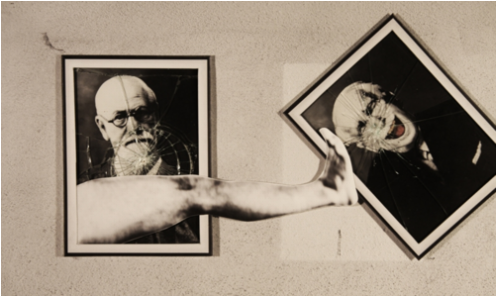Surviving Life (Theory & Practice)
Swimming Lessons with
Dr. Svankmajer
originally published in MACHETE #18, February 2012

_ Jan Svankmajer’s Surviving Life (Theory and Practice), like his previous film, Lunacy, has the distinct feeling of a late-career summation, in which a self-deprecating professorial tone overtakes any more exploratory impulses. Confidently employing the innovative techniques that he pioneered and has long mastered (a frenetic mixture of live action and stop-motion animation), Svankmajer provides an overview of the themes and influences that have pervaded his 45-year career. Whereas Lunacy took on Edgar Allen Poe and the Marquis de Sade, Surviving Life tackles Freud, Jung and psychoanalysis (the film is subtitled A Psychoanalytic Comedy). Although Svankmajer satirizes psychotherapy and its institutionalized dogmas, his approach to the psychoanalytic is unfashionably complex and earnest. This is not surprising given that Svankmajer remains a committed surrealist, perhaps the last one still drawing breath. Willfully indifferent to current cinematic and cultural trends, Svankmajer’s jarring low-fi surrealism resists providing the familiar slick pleasures of dream-imagery spectacles. In an era when surrealist tropes have long become a mainstay of popular culture, and psychoanalysis has devolved into a tool for insular personal fulfillment (as well an irresistible dramatic device for screenwriters), Svankmajer insists on the power of both as valid means of piercing through the oppressive untruths, both political and personal, that we allow to constitute reality.
Ambiguously set in a de-beautified Prague where details of communist and post-communist life anachronistically mingle, the film’s plot revolves around Eugene, an office clerk in late middle age who falls in love with a beautiful, mysterious woman who keeps appearing in his dreams. Neglecting his drab wife and job, Eugene becomes obsessed with his dreams. He goes to a psychiatrist, who analyzes him according to comically orthodox psychoanalytic theory as feuding portraits of Freud and Jung react on the wall behind them. However, he’s outraged when he realizes the doctor only wants to figure out his dreams in order to cure him of them. Eugene wants the opposite: he wants to figure out how to keep the dreams going. He starts to supplement the therapy with occult methods when he discovers a rare book on dream induction. After being fired for reading the book at work, he rents a cluttered shack and spends his days on a cot, drugged on sleeping pills, exploring his obsessive dream world.
In contrast to contemporary film culture, in which money is a benign enabler and the unspoken raison d’être, money explicitly haunts Svankmajer’s film as an obstacle and an imposition. In a coy prologue, Svankmajer addresses the audience directly as a paper-cut-out animation, introducing us to the film’s style. He tells us the film was supposed to be live action but they couldn’t raise enough cash so they decided to use animated photographs to save money on actors (“Photographs don’t eat”). He then quotes Georg Lichtenberg: “Only the fusion of dream and reality can make up the complete human life,” adding, “Sadly our civilization has no time for dreams, there’s no money in them.” An upcoming lottery jackpot, which Eugene’s wife is desperate to win, looms over his waking and dreaming life (in his dreams he buys lottery tickets at the box office of movie theatre named World Cinema). While money is little more than a mundane burden for Eugene before his dream obsession, it takes on near-magical qualities when he starts using it to pursue his dream life. When he pays the inflated price for the occult book, he finds the face of his dream woman on his bills. The bookshop owner is impressed with the unusual money and buys it from him for double its worth. Money becomes both meaningful and self-generating once Eugene invests it with the power of his dream life. Here, Svankmajer succinctly illustrates money’s status as an empty signifier dependent on psychic projection: money functions in reality only when it is imbued with the ‘unreal’ powers of fantasy – in other words, only when it is fetishized. (Incidentally, this is more or less the reverse of the logic governing Christopher Nolan’s recent big-budget dream film Inception, in which the investigation of dreams can only be conceived when monetized.)
By the end of the film, which features Svankmajer’s richest narrative to date, Eugene succeeds in discovering the basic meaning of his dream – he uncovers a secret from his childhood (his mother’s suicide) and realizes the woman in his dreams is a stand-in for his mother (though even his psychiatrist admits that it’s more complex than the usual Oedipal cases). While this is the source of some satisfaction, it resolves nothing for Eugene. When his wife forces him to choose between her and his dreams, he returns to his cluttered shack. However, Svankmajer subversively follows the rules of comedy to live up to his subtitle: order is restored and the lovers are united, but only in the twisted dream world. In the remarkable final scene, Eugene dreams himself into an infantile state and discovers his mother/dream woman in a bathtub full of bloodstained water, her wrists slit. Awaking from the dead, she smiles and lifts him into the tub, telling him that everyone must learn to swim to survive. The final image is of Eugene, with the head of a middle-aged man on the body of an infant, learning the breaststroke in his undead mother’s bloody bathwater as she rhythmically counts out his strokes. This is Svankmajer's image of a valuable life lesson learned, as well as a summation of his art: adult lucidity forced to navigate back to the horrors of childhood, which are the raw horrors of existence, and discovering perverse comfort there. However, if Eugene seems to choose fantasy over reality, this is not a cynical or escapist gesture in the Hollywood mode. For Svankmajer, choosing to inhabit one’s dream world is choosing to live a complete life: not an escape from reality nor a repudiation of it, but a headlong plunge into the muck.
